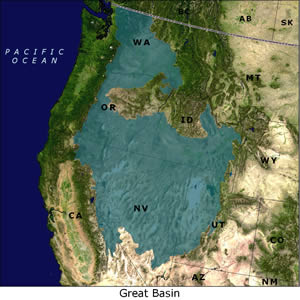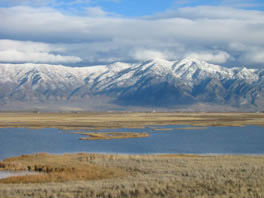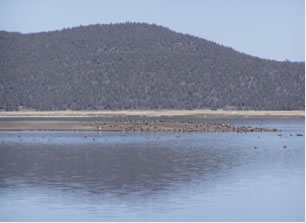Level II Ducks Unlimited conservation priority area, major production area for Pacific Flyway waterfowl

The Great Basin region lies in the rain shadow of the Cascade and Sierra Nevada mountain ranges. The limited wetland areas are threatened by various human activities and provide vital habitat for waterfowl and other wetland wildlife in this otherwise dry region. Continued population growth is placing increased demands on limited freshwater supplies which are needed to sustain wetlands and to help prevent disease outbreaks. Water quality and quantity are the chief concerns for Intermountain West and Great Basin wetlands.


Oregon | Idaho | Nevada | Utah | California | Washington
There are some 1.6 million ha of waterfowl habitat in the Intermountain West – Great Basin region of the U.S. (Sanderson 1980). There are two major subregions west of the Colorado Plateau and east of the Sierra/Cascade crest: (1) Columbia Basin/Snake River Plains and (2) Great Basin (Kadlec and Smith 1989). Each subregion consists of higher elevations areas interspersed with lakes, wet meadows, and streams with lower elevations areas dominated by rivers with broad, meandering floodplains that typically flow into terminal basins.

Important wetland regions in the Columbia Basin/Snake River Plains include: the channeled scablands and potholes region in eastern Washington, Yakima River floodplain, wetlands created and enhanced by the huge Columbia Basin irrigation project, mid-Snake River region, the mid-Columbia River region on the Oregon/Washington border, and the extensive marshes and floodplains in the upper Snake River basin in eastern Idaho, including the Henry's Fork watershed.
Wetlands in the Great Basin are generally associated with rivers, lakes, or springs, or are formed as terminal basins. Some 45 significant terminal basin lakes exist today in the Great Basin, covering about 1,012,000 ha, of which almost half is the Great Salt Lake and associated wetlands found along the Bear, Jordan and Weber Rivers.
The importance of the Great Basin and the Columbia/Snake Basin to waterfowl is perhaps best captured by Kadlec and Smith (1989:451) who state: "In contrast to the perception that the Great Basin is a ‘desert' of little value to waterfowl, the reality is that the marshes and wetlands are of higher value to waterfowl than are many areas in wetter regions. In fact, the very rarity of marshes in a dry region adds to their value. "Because of limited numbers of wetland stopovers in the Great Basin, large and spectacular concentrations of migrating waterfowl often are found on suitable areas (Chattin 1964, Smith and Kadlec 1986)." The importance of this region is primarily as a migration stopover during both spring and fall. The Klamath Basin has attracted greater than 5 million waterfowl during migration, and prior to water diversions and habitat degradation was considered the single most important waterfowl habitat in the U.S. (Gilmer et al. 1982).
Recent estimates of migrants through this region include over 3.5 million mallards and northern pintail, and over 1.2 million green-winged teal, northern shoveler, and American wigeon. The majority of these birds migrate through the Great Salt Lake watershed, with many overwintering in the Lake's river delta marshes. The Snake River and Columbia Basin also see a multitude of migrants, however more moderate temperatures enable this subregion alone to winter 32,000 Canada geese and 1.1 million mallards.
Marshes of the Great Basin produce many waterfowl from a variety of species. Mallards and Canada geese are produced largely in the Columbia/Snake River Basin, whereas cinnamon teal, canvasbacks, redheads and gadwall are produced largely in the Great Basin subregion.
Ducks Unlimited uses cookies to enhance your browsing experience, optimize site functionality, analyze traffic, and deliver personalized advertising through third parties. By continuing to use this site, you agree to our use of cookies. View Privacy Policy